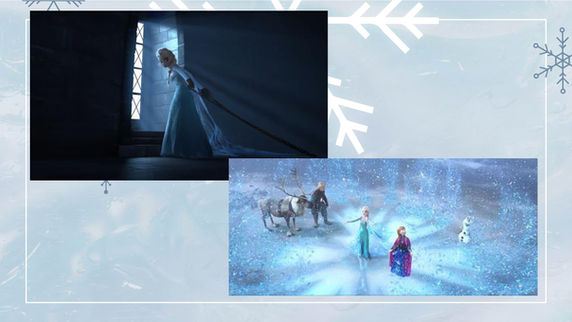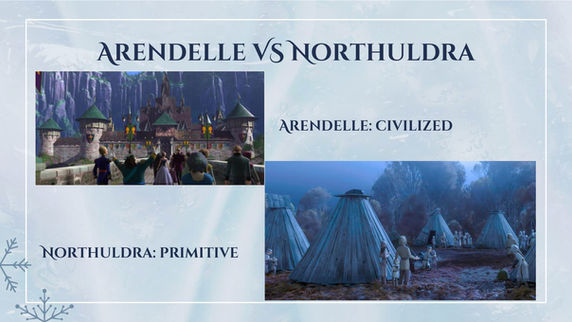TED Talk

Slide 1
Hi everyone, today I want to talk about The Untold Story of Frozen. When I was 7, the Disney film Frozen went viral. Who remembers your younger self belting out “Let It Go” at the top of your lung? I certainly do!
Slide 2
Well, if you don’t, let’s watch a video first. I was one of those kids of course. I felt like I had magic, just like Elsa.
Slide 3
But then, in Frozen II in 2019, something changed. I heard a mystifying, haunting voice calling Elsa. And it made me stop and ask: What stories are we hearing in these movies? And, more importantly, what stories are still untold behind this glittering fairy tale?
In case you already forgotten the plot, let’s go over it quickly.
Slide 4
In the first Frozen, Elsa, born with uncontrollable ice powers, accidentally plunges her kingdom into eternal winter. She flees, builds an ice palace, and her sister, Anna, teams up with an iceman Kristoff, a reindeer Sven, and a snowman Olaf to bring Elsa back.
Slide 5
After a betrayal from Anna’s fiancé, Elsa realizes that love, not fear, is the key to controlling her powers.
Slide 6
Frozen II takes us deeper, where Elsa hears a mystical voice.

Slide 7
It leads us to a forgotten conflict and uncovers a dark history of Arendelle’s colonialism over the Northuldra people. In the film, Arendelle is a powerful kingdom, while the Northuldra are an indigenous group who live in harmony with nature and the elemental spirits. Arendelle once betrayed the Northuldra by building a dam under the guise of friendship, leading to conflicts and the magical forest being sealed off. The film follows Elsa and Anna as they uncover this hidden past and work to restore justice and peace between the two peoples.


Slide 8
OK, here’s the thing — the Frozen movies are huge hits, but they borrow from cultures without fully representing them. How many of you have watched these movies and thought, “Where exactly are we? What culture is this even based on?” The setting feels Nordic, but can anyone name the culture behind it?
Slide 9
Or the music, which sounds so magical and exotic — does anyone know where it comes from? Most of you probably don’t. And that’s the problem. Disney borrowed cultures without giving them proper credit.
Slide 10
Imagine a film about 嫦娥奔月—the Chinese story of Chang'e flying to the moon—and it wasn’t clear that it was a Chinese tale. Wouldn’t that be disrespectful? Failing to properly credit a culture can lead to misrepresentation or even erasure in mainstream media.
This IS cultural appropriation. And that’s why the untold story of Frozen matters.
Slide 11
Now, let’s dig into it. The Frozen movies are heavily inspired by the Sámi people, an Indigenous group from northern Scandinavia, Finland, and Russia. The Sámi are known for herding reindeer, fishing, and hunting, and they have a rich, unique culture.
Slide 12
They’re known for their traditional music called joik — a type of song that’s more about the music than the lyrics, and it’s deeply spiritual. It’s one of the oldest musical traditions in Europe. They wear gákti, traditional clothing adorned with vibrant colors and patterns, each representing family history. The Sámi have suffered centuries of colonization—land grabs, forced assimilation, and attempts to erase their culture. And they’re still fighting today to protect their rights and cultural survival.
Slide 13
Now, back to the movies. Let’s first talk about the hidden Sámi influence in the music. Listen to the opening chant in Frozen, “Vuelie” . Feels magical, right? But what if I told you that this is based on a traditional joik? Let me play you a real joik. Hear the difference? “Vuelie” was composed by a Norwegian musician, Frode Fjellheim, who isn’t Sámi. Disney used a joik-inspired piece without getting proper consent from the Sámi. The problem? Joik is spiritual, not entertaining. As Sámi scholar Ánde Somby puts it, “Joik is not just a song—it’s our connection to the land.” Yet Disney used it as a soundtrack. What’s more troubling is that this isn’t just a legal issue about consent. It reflects a deeper cultural misunderstanding. By extracting a culturally sacred form of music and repackaging it for mass entertainment, Disney oversimplifies a rich heritage. Joik carries stories, emotions, and spiritual connections to the land and ancestors—things that can’t be captured in a background track. Reducing it to a mystical audio extract erases the meaning it holds for the Sámi people.
Slide 14
Another example of misrepresentation is Kristoff’s clothing. This right here is a traditional Sámi gákti, and this is what Disney turned it into. It’s clear cultural appropriation. The Sámi clothing is sacred—it’s not a costume. When companies, including Disney, use it without acknowledging its origins, they erase its meaning. Sámi artist Outi Pieski said it best: “Our clothing isn’t a costume. When they wear it without our stories, it’s another erasure.” And here’s the kicker: Sámi artists are fighting against fast fashion brands that steal gákti designs, and Disney profits from merchandise inspired by this sacred attire.
Slide 15
After backlash from the first Frozen, Disney consulted the Sámi Parliament for Frozen II. Sámi leaders entered into a contract with Disney to make sure the sequel was culturally sensitive. They even agreed to produce a version of Frozen II in a Sámi language. And the Sámi community appreciated this effort: “We’ve been approached by many filmmakers,” said Anne Lájla Utsi of the International Sámi Film Institute. Disney is making progress, and in Frozen II, they did give credit to the Sámi culture by having the Northuldra characters perform the joik in an encore.
Slide 16
But let’s not get ahead of ourselves. Frozen II still carries colonial influence. The Northuldra are depicted as a mystical, primitive tribe, while Arendelle is portrayed as a civilized, progressive kingdom.
Slide 17
Guess who saves the day? Elsa, the “white savior,” swoops in to fix their curse. Does this sound familiar? It’s a colonial narrative, one where indigenous people are trapped in the past, waiting for a savior to come from the outside.
Slide 18
In reality, the Sámi people are not waiting to be saved—they’re out there fighting for their land and their culture. But Frozen II erases that reality.
Slide 19
And now, let’s come full circle. Remember “Let It Go”? We all know the lyrics: “No right, no wrong, no rules for me.” Elsa embraces freedom and individuality, rejecting societal expectations. However, Sámi culture values family and ancestral connection. Personal freedom isn’t the central theme; it’s about community and continuity. So, Frozen presents this Western ideal of self-expression as if it’s universal, but what if it’s not?
Today, you know the untold story of Frozen. You’ve learned about the Sámi culture, the importance of authentic representation, and the need to be critical of the media we consume.
Slide 20
Frozen isn’t the only movie guilty of this—it’s also true for Mulan, Pocahontas, and many others. Mulan follows a young Chinese girl, Mulan, who disguises herself as a man to take her aged father's place in the army. Through bravery and intelligence, she helps save her country from invasion and earns honor for her family. Pocahontas tells the story of a Native American girl, Pocahontas, who falls in love with English settler John Smith during the colonization of Jamestown. As tensions rise between her people and the invaders, Pocahontas seeks peace and understanding between the two worlds. Both movies contain cultural misrepresentation and colonial narrative. In Mulan, western cuisine like fried eggs and bacon appear in ancient Chinese breakfast. As in Pocahontas, the Native Americans are described as clueless, or “don’t know any better”.
Instead of boycotting these films, let’s develop the ability to view them critically and uncover the untold stories behind them.
still love singing “Let It Go” — but now, when I hear the music, I don’t just hear magic. I hear the echoes of a culture that deserves more than being background music. So next time that haunting voice calls to Elsa, ask yourself: Do you really know whose stories you're hearing?
Slide 21
At last, I want to share a sami version of let it go with you.
Slide 22
These are my references.
Slide 23
Thanks for listening.












































